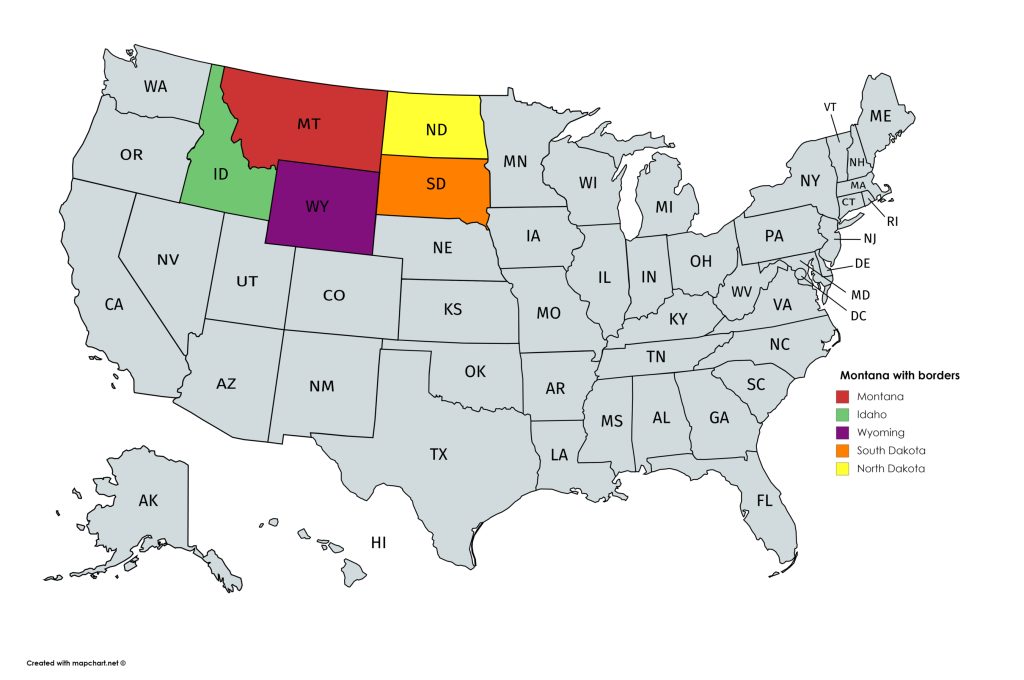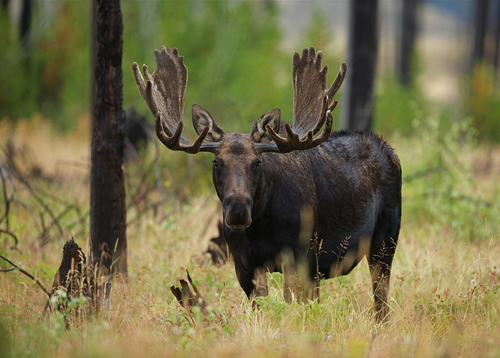Last updated on May 5th, 2024
Montana is the 43rd most populous and the 4th most extensive of the 50 states of the United States. It lies in the North-western United States. Montana attained statehood on November 8, 1889, becoming the 41st state to join the union. Its four bordering states are South Dakota, Wyoming, Idaho, and North Dakota. See the full list of the 50 states and their borders here. Montana (nicknamed: the Treasure State) has 56 counties. The state’s capital is Helena. The abbreviation for Montana is MT.
Interesting facts about Montana
1. The name Montana has a Spanish origin. The earliest Spanish settlers named the state “Montaña” and it means mountain in Spanish. Montana is one of the nine mountainous states located in the western United States.
2. The Paleo-Indians lived in the area known as modern-day Montana more than 10,000 years ago. They were the first to settle in this area after the final glacial era.
3. The first permanent settlement that was established in Montana by Europeans was the St. Mary Mission. In 1831, the Salish people brought a missionary to their village to teach them about the new religion and medicine.
4. New France was the claim France had, and they were the first Europeans to claim the area known as Montana. The largest territory claimed by the French was later named Louisiana.
5. Bannack is the first territorial capital of Montana. It is preserved as a ghost town today.
Montana on the map
6. Montana is the 41st state to be formed in the U.S. preceded by South Dakota and succeeded by Washington. It was incorporated into the union on November 8, 1889.
7. Montana is the only state that is exactly one time zone wide. The state’s eastern border marks the line of Central Time and the western boundary marks Pacific Time. Montana is entirely within the Mountain Time Zone.
8. Montana is one of twelve states with a single area code for telephones. 406 covers the entire state.
9. Montana has two popular nicknames. It is called the “Big Sky Country” and it is also called “The Treasure State”.
10. Montana also has two popular slogans associated with its name – the “land of the shining mountains” and the “last best place.” Montana has more than a 100 mountain ranges in its western half.
11. Montana is one of only five states with no sales tax, along with Alaska, Delaware, New Hampshire, and Oregon.
12. Montana has two important revenue-generating industries. They are mining and agriculture.
13. Montana has huge deposits of natural and mineral resources. Some of these resources are zinc, copper, silver, lead, oil, manganese, gold, timber and zinc.
14. Extremely beautiful and fine blue sapphires are found in the Yogo Gulch in Montana. There are four main sites where rich deposits of sapphires can be found in this state.
15. Coal lies underneath about thirty-five percent of Montana, part of what may be the largest coal basin on earth. If all of Montana’s coal reserves were mined and the mines continued production at their current rate, the coal would run out in about 3,000 years.
16. In the 1870s the invention of electricity and the popularity of indoor plumbing spurred a great need for copper to carry electrical current and water. Butte had a lot of copper. Thirty percent of the nation’s copper, and fifteen percent of the world’s copper, was supplied by Butte in the 1880s. In the process, what was once “the richest hill on earth” was transformed into the deepest lake in the state, called the Berkeley Pit. This toxic lake is about 1,800 feet deep. By comparison, the deepest natural lake in the state is Tally Lake near Whitefish, which is 500 feet deep.

17. In the 1880s copper king William Clark, the richest person on earth, was earning $17 million a month from his mine holdings in Butte. Meanwhile, workers in his mines earned $3.50 per day. Wages remained $3.50 a day for nearly 40 years, until they got a raise in 1917 to $5.25 per day.
18. Around 18,000 miners were working in 138 mines in Butte in 1917. A century later, the invention of fiber optic cable for communication and PVC pipe for plumbing led to the collapse of the copper market. There are around 250 miles of streets in Butte and over 2,500 miles of underground mining tunnels beneath the streets.
19. The motto of Montana is “oro y plata” and this means “gold and silver” in Spanish. This motto is taken from the gold and silver deposits in the state. Gold was first discovered in Montana in 1852.
20. The Alder Gulch, also known as the Alder Creek in the Ruby River Valley, Montana, is one of the richest placer gold sites. It is also the place where the majority of the Montana population lives.

21. Montana has a very low population density. Of the state’s 56 counties, 46 counties have average populations of just 6 people or less per square mile. This is why these counties are considered “frontier counties”.
22. The land has an average of 7.4 people per square mile. Only Alaska and Wyoming have fewer people per square mile than Montana. The national average is 75 people per square mile. The state with the densest population is New Jersey, which has an average of 7,354 people per square mile.
23. About 48 percent of Montana residents live in rural areas, compared to a national average of 25 percent. Around 80 percent of Montana communities have populations of 3,000 or fewer.
24. Only four of Montana’s 56 counties have populations over 100,000. Top on the list is Yellowstone County (Billings) with 163,593 people, followed by Missoula County (Missoula), Gallatin County (Bozeman), and Flathead County (Kalispell).
25. Four of Montana’s 56 counties have fewer than 1,000 residents.
26. Montana has a large population of Native Americans. This state has at least eight federally recognized Native American tribes.
27. The largest city in Montana is Billings and the capital city is Helena. Billings is the only city in Montana to have a population of more than 100,000 people. Just over 10 percent of the population of Montana lives in Billings.
28. There are more cattle than human beings in Montana. But this is not surprising because the state is an important center of livestock farming.
29. Montana has the largest variety of mammals in the United States. Some of these animals are elk, bison (the largest land mammal in North America), grizzly bears and buffaloes.

30. Montana has a large population of grizzly bears. This is probably why the grizzly bear is the state animal of Montana. An estimated 1800 grizzly bears are thought to be alive today.
31. The only state with more grizzly bears than Montana is Alaska. Today there are around 1,800 grizzly bears in Montana. Only 10 percent of grizzlies living in the northern Rocky Mountain region die of natural causes; the rest are killed by humans, either deliberately or accidentally. The grizzly became Montana’s state animal in 1982 when 52,000 school children voted on the issue. The runner-up was the elk. The only land mammal with a slower reproduction rate than the grizzly is the musk ox of Alaska.
32. Millions of bison used to roam the plains of Montana. It took only seven years to reduce their numbers from an estimated 60 million to just 541 left in the world by 1889. Today about 500 bison live at the National Bison Range in Moise, Montana, in addition to a number of privately-owned herds. Yellowstone National Park has between 3,000 and 5,000 bison at any given time.
33. Cows outnumber humans in Montana more than two to one. Black Angus and Hereford are the most popular breeds. Miles City bills itself as the “cow capital of the world” while Drummond boasts that they are “world-famous bull-shippers.”
34. Montana has a huge population of wild buffalo. You can see many of these animals at the National Bison Range close to Missoula.

35. Montana is home to approximately 8,000 moose. This animal was once considered extinct but it is alive in well in Montana.

36. Approximately 10,000 white pelicans migrate from the Gulf of Mexico to Medicine Lake, Montana every spring. These birds are striking because they have wingspans of about nine feet.
37. Did you know the Montana’s official state bird, the western meadowlark, is not really a lark? Studies showed that it should not be part of the lark family and is not of the same species as the eastern meadowlark.
38. Montana has the largest population of golden eagles in the United States. You can see more eagles on a single day here than anywhere else in the United States.
39. The beaver is the largest rodent in Montana, weighing up to ninety pounds. Its teeth can grow an inch in a single month. The porcupine is Montana’s second-largest rodent, weighing up to forty-five pounds.

40. The bitterroot is the Montana’s state flower. It can live for over a year without water and can be revived even after being boiled, dried, or pressed. Its Latin name Lewisia redivivareflects its tenacity with “Lewisia” being for Meriwether Lewis who cataloged it, and “rediviva” meaning “one who lives again.”
41. In the area, it is slightly larger than Japan. It is also the largest landlocked U.S. state.
42. Montana has a large international border with Canada. It is the only state in the U.S. to share a land border with three Canadian provinces (British Columbia, Alberta, and Saskatchewan).
43. Montana is large enough to contain six American states. You can fit the states of Delaware, Pennsylvania, New York, Maryland, Virginia and the District of Columbia into Montana.
44. Beaverhead County, with 5,542 square miles, is Montana’s largest county, equal in size to the state of Connecticut and Rhode Island. It’s the 40th largest county in the U.S.
45. The tallest point in Montana is the Granite Peak. It stands at a height of 12,807 feet. It is the tenth highest point in the U.S.
46. California is the only state that has more hiking trails than Montana’s 15,000 miles of trails.
47. The shoreline of Fort Peck Reservoir is equal in length to the California coastline. They are both about 1,500 miles long.
48. There are almost three times as many miles of railroad tracks in Montana than there are miles of interstate highways: 3,300 miles of rails but only 1,200 miles of interstate. There are almost three times as many miles of groomed snowmobile trails as interstate highways at 3,700 miles.
49. From the source of a river to the point where it exits the state, the average descent in altitude for a typical Montana river is about 3,000 feet.
50. About 70 percent of Montana’s streamflow originates from melting snow. 98 percent of all water used in the state goes towards agricultural irrigation.
. . . continue reading on the next page
